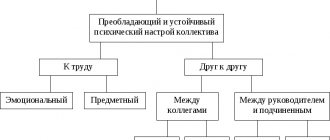Psychological contact is the main way to establish strong relationships between different people.
Without communication, it is impossible to form large corporations, conclude deals, sell goods, find partners, allies, and friends.
In order to correctly establish psychological contact and get the desired result, you need to learn how to use different methods of developing communication, understand how a dialogue should begin, what you can ask, and what it is better to keep silent about.
How to please your interlocutor?
Establishing contact involves three main points:
- Verbal interaction. It implies proper communication with a person. The speech should not contain obscene expressions or swear words. The cleaner and more beautiful it is, the more pleasant it is to listen to it.
- Voice interaction. It is necessary to communicate in a calm tone, carefully pronouncing each phrase. If a person jabbers or swallows half the words, then it will be quite difficult to understand him.
- Visual communication. A pleasant interlocutor must look neat, his facial expression must be friendly, and he must smell good. It is unlikely that anyone will enjoy communicating with an unkempt person.
- Non-verbal communication. This concept refers to gesture technology. If a person constantly fusses, waves his arms and makes sudden movements in an attempt to explain something to his interlocutor, then he will arouse suspicion. Psychologists assure that an open, confident posture promotes trust.
Thus, the technique of establishing contact with a client rests on three main pillars: a neat appearance, competent communication and a beautiful voice. Judge for yourself, who would you trust more? A pleasant person who knows how to convey information correctly or an unkempt person who utters chaotic phrases and makes incomprehensible gestures. Agree, the conclusion is obvious.
Barriers to interaction and ways to eliminate them
Often something gets in the way of meeting a new person or continuing communication with an old friend. In psychology, this phenomenon is called a barrier. Obstacles are divided into 2 groups - psychological, communicative. Types of barriers:
- Aesthetic. You don’t want to communicate with your interlocutor because of his unpleasant appearance or smell, or dirty clothes.
- Logical. It is very difficult to communicate with an individual who does not know how to express his thoughts or formulate sentences.
- Semantic. If the interlocutor gives a distorted meaning to sentences or individual words, or understands the topic differently, it will not be possible to come to an agreement.
- Phonetic. Violation of the technique of pronunciation of words often causes hostility in the interlocutor.
- Negative emotions, poor physical condition. Such situations refer to temporary barriers that gradually pass.
- Installation barrier. Occurs when there is a bias towards an individual.
- Motivational barrier. Appears when people have different goals that contradict each other.
To get rid of barriers, you need to learn to control emotions, actions, dress well, and take care of your appearance. When communicating, it is important to analyze your words and not speak without thinking. The main condition for successful contact is a decrease in self-esteem if it is too high.
It is difficult to earn the respect of a stranger and to win him over. To do this, you need to know the basics of psychology, understand the nuances of communication, be able to ask questions and express thoughts. By establishing psychological contact, you can get a new friend, partner or customer.
The first stage is the regulation of relationships
Beautiful appearance and competent speech are not enough to establish psychological contact. In order for the meeting to be as productive as possible, there are five more basic steps that need to be taken.
The first stage involves regulating relationships. A person who is in a society unfamiliar to him will feel slight discomfort. The first thing to do is to remove this psychological barrier.
At the first meeting, you should agree more and argue less. Let your opinion be slightly different from the opinion of your interlocutor, you will resolve this disagreement later. Now your main goal is to relieve verbal tension. If the meeting is in a business setting, it is recommended to talk a little about general topics, such as the weather, sports competitions or politics. Here your assessment of what is happening should also coincide.
If after 20 minutes of communication the duration of pauses has decreased and the dialogue has become more productive, then the first stage of the process of establishing and developing contacts between people can be considered completed.
What is psychological contact
Psychological contact is the process of establishing trusting, friendly relationships. It is based on the search for common interests and goals. Psychological contact means a meeting of one person with another; it manifests itself only in interaction.
How many stages does the structure of psychological contact have? Three:
- Opponents evaluate each other based on appearance and behavior. At this stage, a first impression of a person is formed, people decide whether they want to enter into a dialogue.
- Mutual interest appears. Participants in the conversation move away from the general group and choose their own topic for conversation.
- A dyad is formed. The distance between the participants in communication is reduced, they make joint plans, and are drawn to each other.
Stage two - point of contact
At the second stage of communication with the interlocutor, it is necessary to find common ground. The interested person must first find out more information about the person with whom the meeting is planned. Perhaps he is an avid lover of hunting or fishing, collects antiques, or does handicrafts. You can find out everything about his interests on social networks or through mutual friends. You need to talk about your favorite hobby as if by chance.
The second stage can be considered successful if the interlocutor becomes noticeably more animated during the conversation and periodically returns to his favorite topic. Correctly finding common points of contact guarantees fruitful cooperation and a pleasant impression of yourself.
Stage three - establishing a single principle
Establishing a common principle is the most important stage in the communication process. This concept means forming an opinion about your interlocutor. There are several principles on which further relationships can be based.
- “I’m ready” - a person is a confident person. It is difficult, almost impossible to confuse her with anything. She will perceive any problem not as a limitation, but as a test of her capabilities.
- “I am open” - a person is completely open to his partner. He does not flatter him and directly talks about his positive and negative qualities. Such a psychological object will not say that he will always arrive on time, he will say that he, like everyone else, has human qualities that he cannot control (there will be no vehicle flight, the alarm clock will not ring, a pipe will burst at home, etc.). d)
- “I'm straight” - a person always tells the truth about everything and never embellishes to make himself look better.
All of the above principles play a positive role in the process of establishing contacts between people. There are several principles due to which the interlocutor may form a negative opinion.
- “I am reserved” - a person has difficulty making contact, he does not want to provide information about himself and is not ready for a productive dialogue.
- “I’m not sure” - a person will always doubt his abilities; he will not be able to give an affirmative answer to any question.
Such qualities will allow the interlocutor to understand what kind of person is sitting in front of him, and whether he will have a desire to continue communicating with him.
Concept and general characteristics of communication.
Home Favorites Random article Educational New additions Feedback FAQPage 1 of 3Next ⇒
Concept and general characteristics of communication.
Communication is one of the main psychological categories.
This is a complex, multifaceted process of establishing, maintaining and developing contacts between people, generated by the need for joint activities and relationships.
Communication is carried out using all kinds of symbolic means of human interaction. Communication is a means of transmitting social experience and culture.
Communication allows you to reveal your subjective world to other people, to self-determine and show your characteristics.
Three sides of communication
It is worth noting that communication includes three main components: exchange of information (communicative side of communication), development of a unified interaction strategy (interactive side of communication), perception and understanding of the communication partner (perceptual side of communication) [ on record
].
Communication is a complex, multifaceted process of establishing and developing contacts between people, generated by the needs of joint activities and including the exchange of information, the development of a unified interaction strategy, perception and understanding of another person (Brief Psychological Dictionary. M., 1985). From the definition of communication it follows that this is a complex process that includes three components:
· communication side
communication (exchange of information between people);
· interactive side
(organization of interaction between individuals);
· perceptual side
(the process of communication partners perceiving each other and establishing mutual understanding).
We will look at the specific features of each side of communication a little later. Now let’s look at the types, levels and functions of communication.
Types and levels of communication
So, there are 2 types of communication:
• role-based (i.e., facilitating the implementation of a particular activity);
• personal (in itself an independent speech activity that is communicative in nature).
However, this is not an absolute classification and these types of communication can smoothly flow into each other.
In addition, A.I. Volkova distinguishes communication by content, goals and means of communication.
The content of communication can be
— material (exchange of objects and products of activity);
— cognitive (knowledge exchange);
- conditional (exchange of mental and physiological states) - people influence each other, designed to bring each other to a certain physical or mental state;
— motivational (exchange of motivations, goals, interests, motives, needs);
— activity (exchange of actions, operations, abilities, skills);
- direct (carried out with the help of natural organs);
- indirect (use of special means and tools to organize communication and exchange of information).
2. According to the level of interaction of individuals in the communication process:
— person-oriented (interpersonal);
- socially oriented (intergroup interaction, as well as individual - group);
— subject-oriented (the basis of such communication is the communication process, and the individual characteristics of the recipients are not taken into account).
3. By means of communication:
- direct and indirect;
- direct (personal presence of interlocutors) and indirect (through intermediaries).
Also distinguished are business (communication included in any private activity serves as a means of improving the quality of this joint activity) and personal communication (concerns a person’s personal problems, relationships between people, the meaning of life, etc.), instrumental and target (communication itself according to itself a means of satisfying the need for communication).
Interpersonal and mass communication
Interpersonal – direct, more or less constant regular communication in small groups. The main condition for interpersonal communication is a certain knowledge by the participants of communication of each other’s individual characteristics, which is possible only on the basis of shared experience, empathy, and mutual understanding.
Mass communication is multiple, usually fleeting, direct contacts of people unfamiliar with each other.
They also distinguish between imperative, manipulative and dialogical communication.
Imperative communication is authoritarian, directive. One partner seeks to subjugate the other, wants to control his behavior and thoughts, and forces him to take certain actions.
Manipulative communication – the goal is to influence the communication partner, while achieving one’s intentions is carried out covertly. The partner is perceived as a bearer of certain “needed” properties and qualities.
The imperative and manipulative form of communication can be characterized as monologue communication. A person who views another as an object of his influence, in fact, communicates with himself, without seeing the true interlocutor, ignoring him.
Dialogical communication is based on the equality of partners. It allows you to achieve deeper mutual understanding and self-disclosure of interlocutors. Dialogical communication occurs when the following rules of interaction are met:
— psychological attitude towards the emotional state of the interlocutor and one’s own psychological state (following the “here and now” principle);
- complete trust in the partner’s intentions without assessing his personality (principle of trust);
— perception of the interlocutor as an equal, having the right to his own opinions and decisions (the principle of parity);
— the focus of communication on common problems and unresolved issues (the principle of “problematization”);
- addressing the interlocutor on one’s own behalf (without reference to someone else’s opinion), expressing one’s true feelings and desires (the principle of personifying communication).
Well, we’ll look at another option for distinguishing types of communication - verbal and non-verbal - in more detail a little later.
Communication functions
B.F. Lomov attributed the following functions :
information and communication, covering the processes of receiving and transmitting information,
· regulatory-communicative, associated with mutual adjustment of actions when carrying out joint activities,
· affective-communicative , relating to the emotional sphere of a person and meeting the needs for changing one’s emotional state.
Levels of Communication
- phatic (a simple exchange of remarks to maintain a conversation in conditions where the communicants are not particularly interested in interaction, but are forced to communicate.
- informational - the exchange of new information that is interesting to the interlocutors, which is the source of any type of human activity (mental, emotional, behavioral). It is stimulating in nature and prevails in conditions of joint activities or when meeting old friends.
- personal level - characterizes such interaction in which subjects are capable of the deepest self-disclosure and comprehension of the essence of another person, themselves and the world around them. Spiritual level. This level occurs in special cases: inspiration, insight, a feeling of unity with the world. This is a prosocial level, that is, useful for society.
Now we will move on to consider the substantive aspects of communication, namely, we will consider 3 sides of communication: communicative, interactive and perceptual.
Let's start with the communicative side of communication.
The communicative side of communication
So, we have already said that the structure of communication includes three components - three sides of communication:
— communication side (exchange of information);
— interactive side (organization of interaction between individuals);
— the perceptual side (the process of communication partners perceiving each other and establishing mutual understanding).
And the first side is the communicative side of communication, that is, the exchange and transfer of information from person to person. It is the effective use of both verbal and non-verbal means of communication.
Verbal communication
Verbal means of communication include written and oral speech, listening and reading . Oral and written speech are involved in the production of text (the process of transmitting information), and listening and reading are involved in the perception of the text and the information contained in it.
One of the main means of transmitting information is speech. Language is realized in speech and through it through utterances it performs its communicative function.
Language is a system of signs and symbols . Speech is the process of using language . Thus, speech is the realization of language, which reveals itself only through speech. Human speech arises in response to the need to communicate with someone or communicate something. Speech can be more precisely defined as the use of language for communicative purposes.
If words and sentences are considered the main structural units of language, then in verbal communication these are utterances as units of meaning . The constitutive feature of an utterance is its appeal, its targeting.
To the main functions of the language
in the communication process include:
— informational (transmission of information, communication of thoughts, intentions);
— constructive (formulation of thoughts);
- propaganda (inducement, appeal, request);
— emotive (immediate emotional reaction to the situation);
— phatic (exchange of ritual (etiquette) formulas, establishing contact between participants in communication);
- metalinguistic (interpretation function). Used when it is necessary to check whether the interlocutors are using the same code.
Speech is divided into external and internal . Inner speech is a person’s communication with himself. But such communication is not communication, since there is no exchange of information. External speech includes dialogue, monologue, oral and written speech. The problem of dialogue is fundamental to the study of the communication process. Dialogue is a type of speech characterized by dependence on the situation of the conversation, conditionality of previous statements.
The following types of dialogue are distinguished:
· informative (the process of transmitting information);
· manipulative (hidden control of the interlocutor). Speech means of manipulation are: emotional impact, the use of social norms and ideas, linguistic substitution of information;
· polemical;
· phatic (maintaining contact).
The main purpose of communication is the exchange of information of various kinds.
Let's consider the process of carrying out a communicative act:
How communication is carried out (communication process): draw a diagram of the communication process (!!!)
The transfer of information always involves people, that is, participants (people who take part in the communication process as senders and recipients of information).
Speech acquires a certain meaning and can be understood only in the structure of a non-speech context. Context
(or situation) are the circumstances in which the communication process is realized.
***As an example, consider the change in meaning of the phrase “he was holding a bag in his hand” depending on the context. If we are dealing with a detective story, then this phrase can mean, for example, “get ready” - if we are talking about a suspect, and there may be important evidence in the bag. In the context of a festive feast, this phrase may indicate that the person who has been waiting for a long time at the table has finally arrived. In a situation of domestic melodrama, a message about a bag in hands can indicate a quarrel or an hour of separation, when one of your loved ones is about to leave or leave.
Next, the participants in communication (addressee and addressee) transmit something, that is, some message (some information, a set of symbols that have gone through the encoding and decoding procedure, what the addressee sends to the addressee).
A code in speech communication is the language or its variety (dialect, slang, style) that is used by the participants in a given communicative act.
Coding is the process of transforming ideas and feelings into words, sounds and actions.
Encoding the original message means translating it into a set of signs, or signals, that can presumably be understood by the other partner. The choice of encoding method largely depends on the personality of the addressee.
Channels for transmitting information are basically material carriers for signs in which the message is embodied (in speech communication this is oral or written speech).
Decoding is the process of transforming a message back into the form of ideas and feelings.
For successful decryption (decoding)
message requires, at a minimum, that the recipient speak a language similar to the language of the sender of the message.
In the event that verbal and non-verbal keys come into conflict, the process of encoding information becomes significantly more difficult!!!
Information - a message - goes from the sender to the addressee via a transmission channel (the route of the message and the means of its transmission). Messages are transmitted through sensory channels. In direct contact between people, messages are transmitted through two main channels: sound (verbal symbols) and visible signals (nonverbal cues). Note that the more channels are used to transmit a message, the greater the likelihood that communication will be successful.
As a message travels through a channel, it is affected by various noises (any external, internal or semantic stimulus that interferes with the process of information exchange).
External noises are objects, sounds and other environmental influences that distract people's attention from what is being said or done. * for example, a person gives some instruction to another to perform a certain action, and at the same time the radio plays the favorite song of the information recipient, which distracts the information recipient.
Internal noise is thoughts and feelings that interfere with the communication process. * You disconnect from the interlocutor's speech, plunging into your own dreams and thoughts.
Semantic noise is meaning that is unintentionally conveyed by some symbols and interferes with decoding accuracy. * example with a secretary - a “girl”, who is 40 years old (dissonance - thought about it, as a result I listened to everything).
Another very important element of communication is feedback, in other words, this is the reaction of the message recipient to the information he received. Feedback indicates to the person conveying the message how accurately and correctly his message was received and understood.
Feedback is another structural component of any communication situation. The reaction of listeners to the speaker’s statement constitutes the cementing moment of communication; its absence leads to the destruction of communication.
The essence of the process of psychological feedback lies in the need for subjects to develop a unified sign system and a common understanding of the issues discussed during communication. When a person receives information, he first of all perceives it, that is, interprets it. Interpretation depends not only on the information itself, but also on the individual experience of the perceiver , his knowledge, general level of development, etc.
People can perceive the same message differently, give opposite assessments to the same phenomenon, and interpret it in different ways. By communicating information, an individual, voluntarily or involuntarily, conveys his attitude towards it, determined by his value system. Personalization of information affects the fact that it is perceived larger, deeper and more reliable than information transmitted through an inanimate source. Another side of information personalization may be the distortion of content as a result of interpretation or the influence of communication barriers.
In this regard, productive communication is usually accompanied by clarifications, some psychological stimuli of a negative or positive nature , *** for example, assenting or frowning.
People use various methods to show their attitude to the subject of conversation and thereby communicate their own understanding of the issue under discussion. In order to avoid distortion of information, experienced communicators use active listening techniques . *** For example, the following techniques will help to understand your communication partner.
1. Pronunciation.
We repeat our partner’s statements verbatim.
In this case, you can start with an introductory phrase: “As I understood you...”, “In your opinion...”, “Do you think...”, etc.
2. Paraphrasing .
We reproduce the partner’s statements in a generalized, abbreviated form, and briefly formulate the most significant things in his words.
You can start with an introductory phrase: “Your main ideas, as I understand it, are...” or “In other words, you believe that...”.
3. Interpretation and development of ideas .
We try to draw a logical consequence from a partner’s statement or make assumptions about the reasons for the statement.
The introductory phrase could be: “Based on what you said, it turns out that...” or “You think so, apparently, because...”.
The psychological structural components of the act of verbal communication should first of all include communicative intention, design and purpose, that is, the motivational component that determines what, why and why
the author of the statement wants to say, as well as the understanding of the message, that is, the cognitive component.
Communicative intention (or communicative intention) is the desire to enter into communication with another person. Thus, the intention to have dinner and the intention to invite someone to have dinner together differ in the absence or presence of communicative intention.
The intent of the message is the information in its original form that one partner intends to convey to the other, the deep level of generation of the message, at which there is only a vague draft of the upcoming utterance.
In verbal communication, two types of goals are usually distinguished:
that the speaker may pursue -
the immediate goal,
that is, directly expressed by the speaker, and the more distant,
long-term goal.
The main types of immediate goals of communication are:
· intellectual goal:
obtaining information, including evaluation information; clarification of positions; opinion support; theme development; clarification; criticism;
· goal related to establishing the nature of the relationship:
development or cessation of communication, support or rejection of a partner; encouragement to action.
Although people often more or less carefully hide or disguise their distant goals, they can be revealed by the general nature of the conversation, by the involuntary (verbal or nonverbal) manifestations of the speaker.
Understanding a message consists of the recipient's interpretation of the message received. If there is a significant similarity in the partners’ images of the world, the deciphered information will be close to that which constituted the intent of the message - the message will be correctly understood. If the partners’ images of the world are very different, understanding will be difficult.
The process of mutual understanding in verbal communication is significantly influenced by such characteristics of a speech utterance as denotation and connotation, polysemy, synonymy, staticity, mixing observation and evaluation. Let's take a closer look at them.
Each person's life experiences influence the meanings they attach to words. Denotation
is the meaning of a word recognized by the majority of people in a given linguistic community - the so-called lexical meaning.
Connotation
refers to secondary associations of a word shared by one or more members of a given community; in this sense they are subjective and emotional in nature.
***For example, the word “fox” denotes a genus of mammals of the canine family (denotation). However, for a fur industry worker, farmer or hunter, it may be associated with a product or an item from a personal collection; for most speakers of Russian - with cunning and resourcefulness.
Because words can evoke strong emotional reactions, they are often said to have a negative or positive connotation (compare, for example, the connotations of the words "corpse" or "Santa Claus").
So, a person's life experience is one of the most important factors influencing the meaning that he attaches to words. Ignoring this factor makes communication difficult.
Reasons to consider when analyzing why people perceive words differently include time and place. The meanings of a word are not set forever, they change from era to era, from generation to generation, and also depending on the region within one country, not to mention different countries. We must remember this when we talk with those who are older or younger than us, with guests from other cities and regions.
Some words have more than one generally accepted meaning, which can cause mutual misunderstanding in communication. In Russian, examples of such words are “bow” (a food product and a weapon for throwing arrows); "garnet" (gem and fruit); “root” (the underground part of a plant, the main part of a word, a mathematical term), etc. This linguistic phenomenon is called “polysemy.” Polysemy –
the presence of more than one generally accepted meaning in a given speech community.
It is known that a message can be encoded with many alternative but functionally equivalent codes, that is, using different words and phrases. This is due to such a linguistic phenomenon as synonymy -
using different words and phrases to convey similar information.
The specifics of the communication process are also characterized by the presence of communication barriers .
A communication barrier is a psychological obstacle that arises in the way of transmitting adequate information.
A communication barrier is an absolute or relative obstacle to effective communication, subjectively experienced or actually present in communication situations, the reasons for which are the following characteristics of the communicators:
1. Motivational-operational;
2. Individual psychological;
Socio-psychological.
In modern social psychology, various types of communication barriers are distinguished. First of all, these are barriers of misunderstanding :
1. Logical barrier - occurs among partners with different types of thinking. Depending on what types and forms of thinking predominate in the intellect of each partner, they communicate at the level of understanding or misunderstanding.
2. Stylistic barrier – discrepancy between the form of information presentation and its content. Occurs when the message is organized incorrectly. The message must be constructed: from attention to interest; from interest to the main provisions; from main provisions to objections and questions, answers, conclusions, summaries. (using different means of language to express your thoughts).
3. Semantic (notional) barrier - occurs when the linguistic dictionary does not correspond with semantic information, as well as due to differences in the speech behavior of representatives of different cultures. (jargon, slang).
4. Phonetic barrier - obstacles created by the characteristics of the speaker’s speech (diction, intonation, logical stress, etc.). You must speak clearly, intelligibly, and loudly enough. Misunderstanding between two people speaking different languages. Various symbolic means of transmitting information.
are also identified :
— social (subjects belong to different strata of society),
— political (different ideology and ideas about the structure and meaning of power),
- religious (can be determined by the tolerance of the religion itself towards representatives of other faiths), professional, etc.
Relationship barriers appear when negative feelings and emotions interfere with interaction. These may be barriers of fear, disgust, disgust, etc.
In addition, B.D. Parygin proposes to distinguish between two types of socio-psychological barriers:
- internal barriers of the individual associated with norms, attitudes, values, as well as with such personal characteristics as rigidity, conformity, weakness of will, etc.
— barriers, the cause of which is outside the individual: misunderstanding on the part of another person, lack of information, etc.
Nonverbal communication is the interaction between people using non-verbal means, the exchange of nonverbal messages and their interpretation in a given situation.
Nonverbal messages can be encoded through:
1 ) expressive body movements - the so-called expressive behavior of the individual (facial expressions, gestures, postures, etc.);
2 ) sound design of speech (pitch, volume, speed, rhythm, etc.);
3 ) a certain organized microenvironment surrounding a person (that is, the space that an individual can control or change: from the furnishings of an apartment to the distance at which he prefers to speak with an interlocutor);
4) the use of material objects that have symbolic meaning (for example, a bouquet for a birthday; a drawn curtain on a window as a symbol that it is dangerous to enter).
Nonverbal communication
represents the exchange of nonverbal messages between people, as well as their interpretation.
The difference between verbal and non-verbal communication can be represented as follows.
| NONVERBAL COMMUNICATION | VERBAL COMMUNICATION |
| 1. Exchange of messages about what is happening “here and now”, within a specific situation, with people who have entered into direct interaction. 2. Nonverbal messages can hardly be broken down into separate units; their core consists of a variety of movements of the body, face, voice, spatial movements, etc. 3. Nonverbal behavior is spontaneous, involuntary movements prevail over voluntary ones, unconscious ones over conscious ones. 4. People, as a rule, successfully acquire nonverbal language themselves through observation, copying, and imitation. | 1. Exchange of messages that may exist other than the person transmitting them (for example, in retelling or in the form of text) allows you to inform about missing objects or phenomena. 2. The constituent elements of a verbal message (letters, words, sentences, phrases) are clearly separated from each other, their relationship is subject to certain rules. 3. Verbal statements are largely conscious; they are easier to analyze, evaluate, understand, and control. 4. Children are taught to speak on purpose; family and society devote a lot of time and effort to this. |
– their situational nature
– their synthetic nature.
Expressive behavior is difficult to break down into separate units.
- involuntary
The spontaneity of many nonverbal actions is another feature of them.
Finally, if children are taught to speak on purpose (and the family and society devote quite a lot of time and effort to this), then people more or less successfully learn most nonverbal signs themselves - through observation, copying, and imitation.
Thus, while implementing the common function of nonverbal communication for them - to transmit messages concerning the specific state of the communicator, his attitude towards himself, his partner and the situation - each of the channels retains its own specificity. The nature of the message content is determined by coding tools.
How _
we say is often more important than the content of the message itself.
The spoken word is never neutral. Researchers identify the following qualities of the sound design of speech: pitch, volume, speed, rhythm, timbre, melody, sonority, tension. Uncontrolled and partially controlled signals include sound phenomena - moaning, laughing, crying, sighing, etc.
Non-verbal aspects of speech convey messages:
a) about what meaning in a given situation we want to give to a word or statement, using for this purpose such means as stress, pauses, intonation;
b) about the speaker himself - his biophysical characteristics (gender, age, height), emotional state, some personal characteristics. Voice characteristics are the most important factor in shaping our image in the perception of others; Either we own our voice or we become victims of it.
Basic emotions such as fear, anger, joy, sadness, surprise, as well as such emotional states as goodwill, anxiety, and confidence can be quite successfully encoded acoustically.
Thus, the emotion of anger is characterized by a general increase in the strength and pitch of the voice, and an increase in the sharpness of speech sounds. The emotion of sadness, on the contrary, is characterized by a slow rise and fall in the strength and pitch of the voice, increased duration of syllables, and a decrease in the strength and sonority of the voice. The dullness or ringing of the voice reveals the age of the speaker. Rapid speech evokes the idea of an active, energetic person, on the one hand, or an insecure, fussy person, on the other. A low, dull voice, rich in intonations, is associated with a purposeful, strong-willed, decisive person. Rhythmic speech characterizes high spirits.
Anthropological standards and stereotypes of interpretation very roughly characterize the perceived, but nevertheless they are entrenched in the practice of communication, since this has a psychological meaning when establishing contacts between people. These stereotypes are the most common and known to everyone.
Social standards of external appearance are perceived by us as signs of the social status of the perceived person and his role functions . These signs are contained in the constitutional features of appearance, expression, and decoration of appearance with clothing and cosmetics . *** For example, the important posture of a banker, the hands of a driver, the bearing of a military man, the gait of a sailor or ballerina
.
Catching signs of one or another social standard in the external appearance, the cognizer classifies the perceived person as a certain social category of people and, after this, attributes to him his own stereotypical ideas about the psychological characteristics of this category of people.
In addition, for each person, the person known in communication is a significant emotional object. Emotional relationships are predetermined here by the characteristics of physical attractiveness and the expression of external appearance. The results of the experiments showed that at the first impression there is a dependence of the assessment of the psychological qualities of a person on the emotional and aesthetic attitude to the appearance of the perceived person. A person who received a positive assessment of his appearance, as a rule, also received a positive personality assessment, and vice versa.
In-group favoritism
Physiognomic reduction
Stereotypes are a rather simplified image of a person, group, phenomenon or event. It is formed by generalizing public and personal experiences. Allows you to reduce reaction time and speed up the learning process.
Stereotypes have cognitive roots and consequences, and therefore have the following effect: they direct thinking and memory in a certain direction, that is, they force them to find evidence to support them, even if none exists. Therefore, they are resistant to change.
Stereotypes have both pros and cons: on the one hand, stereotypes facilitate perception, saving energy spent on perception and cognition, and on the other hand, there is a possibility of thoughtless attribution of the perceived object to previously known categories, which causes a biased attitude towards it and inaccurate conclusions. A stereotype that helps in one situation may be false and completely inappropriate in another.
Professional stereotypes
Professional stereotype –
this is a personified image of the profession, that is, a generalized image of a typical professional.
V. F. Petrenko studied the stereotype of a psychologist (Petrenko, 1988). According to the stereotype, a “psychologist” is complex, smart, interesting, organized, proud, principled, and witty. Psychologists do not have such qualities as happy and organized. The discovered contrast between “happy” and a whole set of positive qualities reveals the presence of a specific “professional hazard” in the profession of psychologist associated with ordinary neuroticism. The need to analyze other people leads to heightened self-analysis, which removes forms of psychological defense of the individual and makes it more sensitive to frustrating factors.
It should be said that stereotypes are not the only reason for a simplified and schematic view of other people. Barriers to understanding other people are psychological defense mechanisms that distort the truth in the subjective direction a person needs, prejudices and biases.
The essence of interaction is that in the process of joint activity, contact arises due to the individual characteristics of the subjects, the social situation, the dominant strategies of behavior, the goals of the participants in the interaction and possible contradictions.
Interaction (the interactive side is the organization of interaction between people);
Without interaction there is no communication. Interaction is the process of direct or indirect influence of people on each other. On this side, the communicator in one way or another changes the behavior, thoughts and feelings of his interlocutor, organizes his activities - interaction is always determined by some reason.
Interaction, as a rule, goes in two ways: either cooperation (promoting joint activities) or competition (obstruction, although it may not mean conflict at all). The type of interaction is influenced by the relationships established between the interlocutors, their goals and motives.
In the process of interaction between people, signs appear that characterize them as a group of a certain level of development. Contradictions that arise in interaction lead either to the development or to the collapse of the entire structure.
Psychological compatibility - the optimal balance of personal characteristics, mental
1Next ⇒
Stage four - pitfalls
The fourth stage begins when the process of establishing business contact has dragged on for several days. With close proximity, partners will begin to notice that they know incomplete information about each other. You can find out the truth about these “pitfalls” only by acting as an initiator. For example, it seemed to you that the person with you was not direct and open enough. Ask him a provocative question and carefully analyze his reaction. This method will quickly dispel all possible doubts.
Expressing feelings
Nonverbal communication is a means of expressing one’s own feelings towards another person, action, or situation. With the help of touches, they demonstrate a friendly or loving attitude, attract attention, restore peace of mind, and gain leadership.
READ Conversational style of speech: varieties and examples
Safety
This includes hugs, with the help of which one person expresses his readiness to help and support, and the other feels this attitude. The need for hugs arises from birth. It is initially important for a baby to feel his mother nearby, to feel her touch. Over time, the child remembers the mother's voice and then grasps the meaning of the words.
Love
Love is a non-verbal mode of communication that has the greatest effect on interpersonal relationships. It is demonstrated by parents, children, brothers, sisters, relatives and close people. This noble feeling is manifested by hugs, handshakes, and kisses. An increase in the number of touches between a man and a woman indicates that the relationship is becoming personal, and then intimate.
Confidence
Physical contact expressing trust does not occur between strangers. Manifests itself through hugs. When there is trust, a person allows himself to be touched, hugged, kissed.
Friendship
Men do not welcome excessive tactility, but in some situations hugs are allowed. Friends hug when they haven’t seen each other for a long time, want to express their gratitude, and experience a joyful or sad event together. In addition, friends allow themselves to hug while intoxicated, even if the friendship is not that close.
Women are calm about tactile communication if it is not of an erotic nature. Girlfriends often hug, kiss on the cheek and lips, sleep on the same couch, and hold hands for a long time.
When representatives of different sexes are friends, the expression of feelings should be within the bounds of decency. Frequent touching has intimate overtones. Friends definitely don't kiss on the lips. Hugs and kisses on the cheek are allowed.
Sexual innuendo
Nonverbal communication is aimed at attracting the partner's attention. In the process of courtship, with the help of tactile contact, partners demonstrate their desire to become closer. The main means used are caresses, kisses, massage. When a couple meets, it all starts with attention and communication. This is followed by a phase of touching and lovemaking. Tactile communication is present in the final stages.
READ Manipulation - techniques for controlling human consciousness
Touching is initially random. A partner interested in intimacy touches neutral parts of the body. The recipient, who is interested in this development of events, allows this to happen. Then purposeful movements appear, which culminate in sex. With the help of touches, the partner's reaction is checked.
Protection
The manifestation of this feeling is expressed in hugs and stroking. In a situation where a lightning-fast reaction is required, the defenseless partner is pushed to the side in order to stand in front. This behavior is typical of men who protect women, as well as mothers.
What is it for?
It’s worth talking separately about why you need to develop this connection in the process of communication:
- It is important to know the techniques and ways of establishing contact with the client in order to gain his trust. A properly organized conversation will put him in a positive mood - this is the basis of a productive relationship.
- These qualities are essential during an interview. A person who is neatly dressed, speaks well and has positive communication principles has a better chance of getting this job.
- Every businessman should know about the process of establishing and developing contacts. Proper communication will have a huge impact on his performance. Who would want to cooperate with an ignoramus who is unpleasant to communicate with?
- Proper organization of relationship building is necessary for every person. After all, every day people closely interact with other individuals in shops, restaurants, transport and other public places. “Quality” communication creates a positive opinion about yourself.
The need for human touch
In psychology, there are 18 meanings of physical contacts. They were conditionally divided into 7 groups:
- Positive emotional impact.
- Control.
- A game.
- Mixed touches.
- Ritual.
- Targeted.
- Random.
Positive emotions are exchanged between people in good relationships:
- Supportive touch shows care, comfort, protection. Contact is considered appropriate when the interlocutor is in a state of despair, depression, and anxiety.
- With the touch of approval, people express appreciation, gratitude, and also give consent to certain actions.
- Affiliation implies psychological intimacy. Indicates joint interaction, that is, people are engaged in one thing, and physical impact occurs in the process of performing their functions.
- Sexual touching means mutual sympathy, sexual desire, attractiveness.
- Affection shows a person's positive attitude towards their partner.
The touches of play can be impactful and aggressive. The point of contact is that the information should not be taken seriously. In addition, with the help of the game, a person is influenced to obtain a certain effect. Control is needed to direct the partner’s attention in the right direction and provoke a reaction. Ritual touches include greetings and farewells. This includes a handshake and a pat on the shoulder. Random tactile contact does not carry any meaning; it is carried out unintentionally.
Communication between people occurs through words, gestures, and touches. When using all communication tools, there is a complete transfer of information.
Feedback
Feedback is another technique for establishing contact. This approach will allow you to form the right opinion about your interlocutor.
- You need to pay attention to how a person answers the question posed. If he looks into your eyes, this indicates that he is extremely interested, the topic of communication is really close to him. A languid glance at the furnishings in the room or at the window indicates a lack of interest.
- It is a very good sign if a person takes some notes in a notebook during a conversation. This suggests that he approaches negotiations responsibly. You should pay attention to what points he focused his attention on as much as possible.
- During negotiations, various barriers will appear. For example, a person will not understand the decoding of various terms and formulations. It's a good sign if he asks a lot of questions and tries to get to the bottom of the conversation.
Feedback is a very subtle psychological approach. If you want to create a good impression of yourself, it is important to pay attention to these nuances in advance.
These eyes are opposite
You can also easily recognize a person’s emotions and intentions by their eyes. This is best known to men who, upon meeting, immediately evaluate the way the interlocutor looks at him. Moreover, by looking, one can determine the social status, the presence and absence of problems, and even the state of a person’s health. For example, a student a week before the scholarship, a grandmother with a minimum pension and a single mother look at the world with approximately the same eyes. With sadness. Whereas a successful businessman looks at others confidently and boldly. The same expression in the eyes can be found in a child who grows up in a complete family. He has no problems, and the growing man looks to the future with optimism.
More specifically, the interlocutor’s gaze, depending on the situation, can be:
- Secular. In this case, the gaze drops to the lip line or simply below the eye level of the interlocutor. This technique promotes easy and relaxed communication and is used at receptions, meetings and parties.
- Business. Here the gaze is fixed at the level of the interlocutor’s forehead. This is supposed to create a serious atmosphere of business partnership;
- Intimate. The person does not look into the eyes of the interlocutor, but at other parts of the body located below the face (to chest level). This indicates that people are interested in each other. An intimate gaze may be accompanied by dilation of the pupils (in anticipation of pleasure).
- A sideways glance. Indicates a suspicious or critical attitude towards the interlocutor.
Eyes, forehead, mouth, eyebrows, mouth, chin, nose - these parts of the face best express the main human emotions. Positive emotions (love, joy, surprise) can be determined faster and easier; negative human emotions (anger, sadness, contempt) are more difficult to perceive. The main burden in determining the true feelings of the interlocutor is borne by the lips and eyebrows.
Appearance
The most effective way to establish contact during negotiations is to create an attractive image. It is not advisable to dress up in the most expensive suits for an interview. It is important that the image is discreet and neat.
A woman is recommended to wear a stylish dress to negotiations that will highlight all her advantages and hide the flaws of her figure. Another good option is a formal suit. Under no circumstances should clothing show off legs or chest. Such a depraved image is unlikely to inspire confidence in the interlocutor. Hair should be styled as much as possible. It is necessary that the makeup is not provocative, but, on the contrary, emphasizes the natural beauty of the face. For manicure, you should choose discreet varnishes.
A man is recommended to wear a business suit to a meeting. A great alternative would be classic jeans with a shirt. It is not at all necessary that the clothes be from an elite designer. Usually interlocutors pay attention to the quality of shoes and watch brand. An accessory can create a special impression about a person.
We should also talk about the color palette. For an interview, it is not recommended to combine several bright shades. For example, if the blouse or shirt is bright, then accessories, trousers or skirt and shoes should be in a neutral shade.
Non-verbal communication
Nonverbal communication plays an important role. Psychologists call it hidden dialogue. The way a person behaves during a conversation can reveal a lot. For example, if he sits with his hands folded, he is most likely closed or hiding something. An open, relaxed posture indicates his readiness to communicate.
You should be wary if a person is nervous. This may indicate that he is not confident in himself or is hiding something. The following signals will be helpful: if the interlocutor begins to finger something in his hands, for example, actively fiddling with a clothing button or a teaspoon.
You need to carefully examine your facial expression. It’s a huge plus if a person has a friendly smile on his face. This is a sign that he is committed to productive communication.
Body language: the meanings of touch
Tactile communication sometimes provides more information than verbal communication. Knowing body language, you can understand a person and understand his true intentions:
- Handshake. Formal greeting. Indicates a good partner's disposition. The predisposition signal becomes stronger when the opponent places his left hand on his shoulder or on top of his partner's right hand.
- Hug around the waist. It is perceived as a heterosexual gesture because the man's hand is near the woman's genitals. Means an intimate relationship or a hint of sex. Often used in courtship.
- Kiss on the lips. Demonstration of warm feelings between lovers. Sometimes girlfriends or a child can afford such a kiss, touching their lips to their mother.
- Hand on head. The most vulnerable part of the body is the head. Even the lightest touch demonstrates trust, a close spiritual and emotional connection.
- Head to head. Men who are intoxicated allow themselves to do so. The gesture indicates close relationships and support. But such a touch is more typical for lovers. It means the desire of a man and a woman to be close, and far from everyone.
- Weasel. It is part of sexual foreplay. A gesture demonstrated in public indicates an intimate relationship between partners.
- Hand holding. Means support. A child can sit in the arms of his parents, loved ones, or a girl can sit in the arms of her beloved boyfriend.
- Fake Attack game. Kicks, light blows, and pushes in a playful manner indicate friendly relations between men. In this way they fool around and show others their warm relationship.
- Accompanying contact. The partner hugs the other by the shoulders and leads him in the direction he needs. This is a patronizing or controlling gesture.
- Pat on the back. Praise, approval, support, friendship.
- Hand holding. Symbolizes protection and possession. Used in public. Demonstrates the close relationship between a woman and a man.
- Embrace. Shows a warm attitude. Side hug - support. Used by children, parents, friends, lovers when meeting, parting and simply for no reason.
- Hand on shoulder. A male gesture demonstrating friendship, a friendly attitude.
- Holding hands. Used by the mother to hold the child. Adults use this gesture to show others a love affair.
Nonverbal communication is diverse and very informative. For example, a woman adjusting the collar of a man’s shirt warns everyone: “He’s mine.” The gesture is perceived similarly when a man puts his hand on a woman’s waist in front of everyone.
Establishing contact with the child
We should also talk about establishing contact with the child. If you do this correctly, you can noticeably get closer. There are several effective psychological methods to improve interaction. Among them are the following:
- Intense rhythm introduces its own rules into our lives. Mothers are engaged in building their careers, appearance, household chores and other useful things. No matter how hard it is, it’s worth setting aside at least one hour a day to communicate or play with your baby.
- You should communicate with your son or daughter as calmly as possible, without raising your tones. If a parent constantly scolds his offspring, then there is a high probability that he will grow up to be an introverted person.
- You just need to love your child. Read books with him, go for walks, clean the house, cook together and just chat. Even the most qualified nanny with a pedagogical education cannot replace the care of a beloved mother.
Establishing contact with a child is really very important. It promotes the formation of trusting relationships between close people, which is important.










